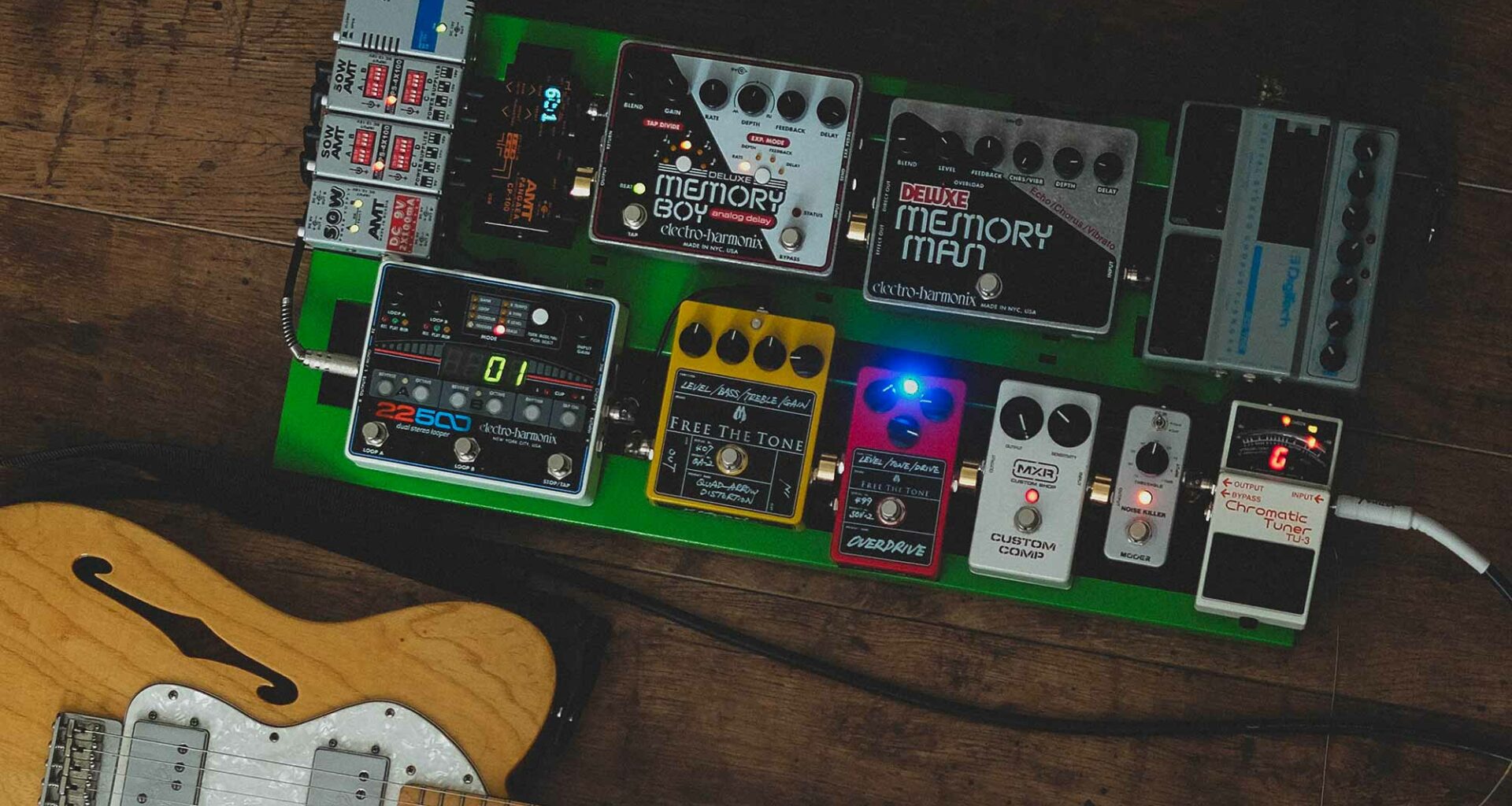When it comes to effects pedals, there are often two main camps that emerge and often find it hard to agree: the fervent defenders of the good old analog vintage sound and the avant-gardists in search of little digital nuggets!
In this article, we’ll try to break down these 2 worlds that are often at odds with each other, exploring all the more or less subjective elements that differentiate these 2 types of effects pedal.

Analog pedals
How it works :
Analog pedals process the audio signal in a purely analog way, i .e. without digital conversion. In other words, they use traditional electronic components such as transistors, diodes and capacitors to sculpt the sound.
Advantages :
- The good old warm, organic sound : Analog pedals are prized by purists for their warm, organic sound. They often add a certain harmonic coloration that can be particularly appreciated in musical genres such as blues, rock or jazz.
- Reactivity to touch : analog pedals are often used for their sensitivity to touch. They react uniquely to input signals. For example, an analog overdrive pedal may saturate differently depending on the strength of the signal passing through it.
- Simplicity of use: the intuitive controls of analog pedals often make them more accessible (no screens with incomprehensible software), ideal for musicians who prefer direct and often simpler adjustment of their effects.
- Ageing and “heating” of components: The electronic components of analog pedals can undergo changes over time. Capacitors, for example, can lose some of their properties over the years, subtly altering frequency response. This can give vintage pedals a distinct and often sought-after sonic coloration.
Component heating is also a notable feature of analog pedals. Some musicians appreciate the fact that the electronic circuitry of an analog pedal can react to temperature variations, producing a sound that evolves as the pedal is used.
Disadvantages :
- Less versatile: Analog pedals can sometimes offer less versatility than their digital counterparts. The limited number of presets and the difficulty of reproducing a configuration exactly can be obstacles or hindrances to their use.
- Size and weight: Analog components tend to be larger and heavier, which can make analog pedals more bulky, especially if you have a large collection…

Digital pedals
How it works :
Introduced in the ’80s, digital pedals convert audio signals into digital data for processing. They use digital signal processors (DSP) to apply a multitude of effects, often with the ability to store programmed presets.
Advantages :
- Extreme versatility and multi-effects: Digital pedals offer an infinite variety of effects and configurations. A single box can often emulate several different analog pedals, which is ideal for musicians exploring different sounds.
- Preset storage: The ability to save and recall presets facilitates rapid switching between different configurations, which is particularly advantageous on stage.
- Compact size: digital components are more compact, making digital pedals lighter and easier to carry.
- MIDI connectivity: Many digital pedals are equipped with MIDI ports, making them easy to integrate into more complex configurations. This enables remote control, synchronization with other MIDI equipment and greater flexibility in pedalboard design.
- Advanced features: Digital pedals can include advanced features such as tap tempo, complex modulations, amp and cabinet simulations, sophisticated routing capabilities and more.
- Evolution and updates: depending on the manufacturer, some pedals can be updated to bring ongoing improvements to digital pedals, adding new effects, optimizing performance and responding to user feedback. This allows musicians to benefit from the latest advances without having to buy new hardware.
Disadvantages :
- Potentially “artificial” sound: Even if this is less and less true with the evolution and improvement of digital pedals, some musicians criticize digital pedals for a sound that is sometimes perceived as artificial (less organic and authentic), especially when they attempt to emulate classic analog effects.
- More complex learning : The diversity of functions and the multitude of parameters to be set can make the use of digital pedals more complex, requiring a greater learning curve.
Initially criticized for their sometimes perceived artificial sound, digital pedals have undergone significant transformations over the years. Constant advances in digital signal processor (DSP) design have considerably improved their sound quality. Early generations of digital pedals were sometimes accused of lacking warmth and responsiveness, but engineers have refined algorithms to accurately capture the subtle nuances of analog sound. Amp and cabinet simulations have gained in realism, offering guitarists the chance to explore a variety of sonic textures. What’s more, some digital pedals now integrate analog components into their processing chain to combine the best of both worlds.

Can analog and digital pedals be mixed on the same pedalboard?
And yes, some guitarists bring the 2 camps together by mixing these 2 types of pedal. This approach offers the best of both worlds, allowing guitarists and bassists to exploit the characteristic warmth of analog pedals while enjoying the versatility and advanced features of digital pedals. The judicious use of each type of pedal can bring interesting sonic richness. For example, placing an analog overdrive pedal in front of a digital delay pedal can create an organic, textured sound while benefiting from the precise settings of the digital pedal. The trick lies in experimenting and fine-tuning signal levels to maintain the desired sonic balance.
The choice between analog and digital pedals depends largely on individual sound preferences, playing style and practical needs. Some musicians even opt for a combination of the two, taking advantage of the unique strengths of each type of pedal. In any case, whether you’re drawn to the authentic warmth of analog or the versatility of digital, the key is to find the equipment that best suits your musical creativity.
What do you think? Are you an analog team or a digital team?









